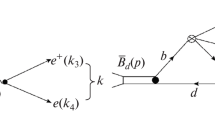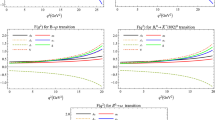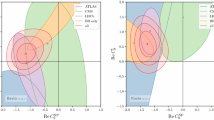Abstract
Rare \(B\)-meson decays induced by the Flavor-Changing Neutral Current \(b \to s(d)\) transitions provide a stringent test of the SM in physics of quark flavors. Being loop-induced in the SM, they are suppressed and effects of New Physics can increase substantially their decay widths. Here, we consider the rare decay \({{B}^{ + }} \to {{\pi }^{ + }}{{\tau }^{ + }}{{\tau }^{ - }}\). We present its dilepton invariant-mass distribution and decay width calculated in the Effective Electroweak Hamiltonian approach for different types of the \(B \to \pi \) formfactor parameterizations. The ratio of the tauonic to muonic decay widths, \({{R}_{\pi }}(\tau /\mu )\), is also theoretically predicted.
Similar content being viewed by others
Explore related subjects
Discover the latest articles, news and stories from top researchers in related subjects.Avoid common mistakes on your manuscript.
INTRODUCTION
Rare decays of bottom hadrons are of extreme importance both in precision tests of the Standard Model (SM) and in searches of New Physics (NP). A majority of such processes are due to the \(b \to s\) and \(b \to d\) Flavor-Changing Neutral Currents (FCNCs). Decays due to the \(b \to s\) quark transition are the most studied, as a lot of experimental measurements are already done. Similar decays induced by the \(b \to d\) FCNC are less attractive because there is still a little information about them. So, the \({{B}^{ + }} \to {{\pi }^{ + }}{{\mu }^{ + }}{{\mu }^{ - }}\) decay is one of such processes which is relatively well studied both theoretically and experimentally. Predictions including subleading contributions [1–3] give a better agreement with experimental data by the LHCb Collaboration [4]. It is also of interest to consider its tauonic counterpart, \({{B}^{ + }} \to {{\pi }^{ + }}{{\tau }^{ + }}{{\tau }^{ - }}\), as a decay to be searched for at the SuperKEKB factory and possibly at the LHC. In the paper we present theoretical analysis of this rare decay. We obtain SM predictions for the ditauon invariant mass distirbution and decay width for various types of form factor parameterizations of the \(B \to \pi \) transition. We estimate also the ratio \({{R}_{\pi }}(\tau /\mu )\) which is the ratio of the taounic branching fraction to the muonic one.
THEORY OF RARE SEMILEPTONIC \(B\)-MESON DECAYS
Theoretical analysis of rare \(B\)-decays is convenient to do within the framework of effective electroweak Hamiltonians. This theory is derived from the SM by integrating out heavy particles—the top quark and \(W\)‑, \(Z\)- and Higgs bosons [5, 6]. The rare \({{B}^{ + }} \to {{\pi }^{ + }}{{\ell }^{ + }}{{\ell }^{ - }}\) decay is induced by the \(b \to d\) FCNC Hamiltonian [5]:
where \({{G}_{F}}\) is the Fermi constant, \({{C}_{j}}(\mu )\) are Wilson coefficients, \({{\mathcal{P}}_{j}}(\mu )\) are the local \(b \to d\) transition operators, \({{V}_{{{{q}_{1}}{{q}_{2}}}}}\) is the CKM matrix element. The \({{\mathcal{P}}_{j}}(\mu )\) operator basis includes 10 operators [6]. The leading-order contribution to the \({{B}^{ + }} \to {{\pi }^{ + }}{{\ell }^{ + }}{{\ell }^{ - }}\) decay amplitude is given by the following operators:
where \(L,R = \left( {1 \mp {{\gamma }_{5}}} \right)/2\) are the fermionic left- and right-handed projectors, \({{F}_{{\mu \nu }}}\) is the electromagnetic field strength tensor, \({{m}_{b}}\) and \({{m}_{d}}\) are \(b\)- and \(d\)-quark masses, \({{\sigma }^{{\mu \nu }}} = i\left( {{{\gamma }_{\mu }}{{\gamma }_{\nu }} - {{\gamma }_{\nu }}{{\gamma }_{\mu }}} \right)/2\), and \(\alpha = {{e}^{2}}{\text{/}}(4\pi )\) is fine structure constant. The summation index \(\ell \) covers all the charged leptons.
The \(B \to \pi \) transition matrix elements are expressed in terms of three transition form factors \({{f}_{ + }}({{q}^{2}})\), \({{f}_{0}}({{q}^{2}})\), and \({{f}_{T}}({{q}^{2}})\), where \({{q}^{\mu }} = p_{B}^{\mu } - p_{\pi }^{\mu }\) is the four-momentum transferred to the lepton pair [7]:
where \({{m}_{B}}\) and \({{m}_{\pi }}\) are the \(B\)- and \(\pi \)-meson masses.
The \(B \to \pi {{\ell }^{ + }}{{\ell }^{ - }}\) differential branching fraction including subleading contributions can be presented as follows [2, 3]:
where \({{S}_{\pi }}\) is an isospin factor of the final meson (\({{S}_{{{{\pi }^{ \pm }}}}} = 1\) and \({{S}_{{{{\pi }^{0}}}}} = 1/2\)), \(C_{{7,9,10}}^{{{\text{eff}}}}\) are the effective Wilson coefficients including the NLO QCD corrections [8], \(L_{A}^{{B\pi }}({{q}^{2}})\) is the Weak Annihilation (WA) contribution, and \(\Delta C_{V}^{{B\pi }}({{q}^{2}})\) are the Long-Distance (LD) ones.
WA contribution [9] has a significant impact only at the beginning of the \({{q}^{2}}\)-spectrum, and its accounting makes sense for the \({{B}^{ + }} \to {{\pi }^{ + }}{{e}^{ + }}{{e}^{ - }}\) and \({{B}^{ + }} \to {{\pi }^{ + }}{{\mu }^{ + }}{{\mu }^{ - }}\) decays. LD contributions are originated by two-body decays, \(B \to V\pi \), where \(V = {{\rho }^{0}},\omega ,\phi ,J{\text{/}}\psi ,\psi (2S)\) are neutral vector mesons, followed by the leptonic decays, \(V \to {{\ell }^{ + }}{{\ell }^{ - }}\) [1]. For the \({{B}^{ + }} \to {{\pi }^{ + }}{{\tau }^{ + }}{{\tau }^{ - }}\) decay considered, the dominant contribution from the \(\psi (2S)\)-meson should be taken into account only, and this analysis is postponed for another publication.
The differential branching fraction (6) involves three \(B \to \pi \) transition form factors (FFs). Among available FF parameterizations, we adopt the following three: the Boyd–Grinstein–Lebed (BGL) [10], Bourrely–Caprini–Lellouch (BCL) [11] and modified Bourrely–Caprini–Lellouch (mBCL) [12].
NUMERICAL RESULTS FOR \({{B}^{ + }} \to {{\pi }^{ + }}{{\tau }^{ + }}{{\tau }^{ - }}\) DECAY
The dilepton invariant-mass distribution of the \({{B}^{ + }} \to {{\pi }^{ + }}{{\tau }^{ + }}{{\tau }^{ - }}\) decay for three types of the FF paramereterizations is presented in Fig. 1. As seen, theoretical predictions based on BGL parameterization are systematically above other types of parameterizations and the total branching fraction for BGL parameterization is the largest one (see Table 1). Our predictions for all the parameterizations in Table 1 are consistent with each other within uncertainties as well as with [13]. The ratios, \({{R}_{\pi }}(\tau {\text{/}}\mu )\), of the tauonic branching fraction to the muonic one are \(0.44 \pm 0.16\), \(0.31 \pm 0.12\), and \(0.37 \pm 0.15\) for the BGL, BCL, and mBCL parameterizations, respectively. As mentioned above, the largest ratio is for the BGL parameterization and the smallest one is for the BCL parameterization.
The dilepton invariant-mass distribution of the \({{B}^{ + }} \to {{\pi }^{ + }}{{\tau }^{ + }}{{\tau }^{ - }}\) decay for BGL (upper left plot), BCL (upper right plot), and mBCL (bottom plot) FF parameterizations. The green areas indicate the uncertainty due to the factorization scale and CKM matrix element \({{V}_{{td}}}\).
CONCLUSIONS
Theoretical predictions for the \({{B}^{ + }} \to {{\pi }^{ + }}{{\tau }^{ + }}{{\tau }^{ - }}\) total branching fraction are obtained in the NLO for three types of the form factor parameterizations. The impact of the parameterization choice is strongly manifested by comparing BGL and BCL predictions and can be explained by the fact that FF expansion coefficients are determined in different \({{q}^{2}}\)-regions. Theoretical predictions for the semitauonic decay give a factor of 2 or 3 suppression in comparison with \({{B}^{ + }} \to {{\pi }^{ + }}{{\mu }^{ + }}{{\mu }^{ - }}\) already measured and it is an attractive process for experimental searches. Note that a detection of tauonic decays with a sufficient accuracy is planned by the Belle-II Collaboration on the scale of the integrated luminosity ~5 ab–1.
REFERENCES
C. Hambrock, A. Khodjamirian, and A. Rusov, “Hadronic effects and observables in B → π+ \({{\ell }^{ + }}{{\ell }^{ - }}\) decay at large recoil,” Phys. Rev. D 92, 074020 (2015).
A. Ali, A. Parkhomenko, and I. Parnova, “Impact of weak annihilation contribution on rare semileptonic B + → π+ \({{\ell }^{ + }}{{\ell }^{ - }}\) decay,” J. Phys.: Conf. Ser 1690, 012162 (2020).
I. Parnova, A. Ali, and A. Parkhomenko, “Subleading contributions in rare semileptonic B + → π+ \({{\ell }^{ + }}{{\ell }^{ - }}\) decay,” PoS, PANIC2021 158 (2022).
R. Aaij et al. (LHCb Collab.), “First measurement of the differential branching fraction and asymmetry of the B ± → π±μ+μ– decay,” J. High Energy Phys. 10, 034 (2015).
G. Buchalla, A. J. Buras, and M. E. Lautenbacher, “Weak decays beyond leading logarithms,” Rev. Mod. Phys. 68, 1125–1144 (1996).
K. G. Chetyrkin, M. Misiak, and M. Munz, “Weak radiative B-meson decay beyond leading logarithms,” Phys. Lett. B 400, 206–219 (1997);
Erratum: Phys. Lett. B 425, 414 (1998).
M. Beneke and T. Feldmann, “Symmetry breaking corrections to heavy to light B–meson form-factors at large recoil,” Nucl. Phys. B 592, 3–34 (2001).
H. Asatrian, K. Bieri, C. Greub, and M. Walker, “Virtual corrections and bremsstrahlung corrections to b → d \({{\ell }^{ + }}{{\ell }^{ - }}\) in the standard model,” Phys. Rev. D 69, 074007 (2004).
M. Beneke, T. Feldmann, and D. Seidel, “Exclusive radiative and electroweak b → d and b → s penguin decays at NLO,” Eur. Phys. J. C 41, 173–188 (2005).
C. G. Boyd, B. Grinstein, and R. F. Lebed, “Model independent determinations of \(\bar {B}\) → D \(\ell \bar {\nu }\) , D*\(\ell \bar {\nu }\) form-factors,” Nucl. Phys. B 461, 493–511 (1996).
C. Bourrely, I. Caprini, and L. Lellouch, “Model-independent description of B → π\(\ell \nu \) decays and a determination of |V ub|,” Phys. Rev. D 79, 013008 (2009).
D. Leljak, B. Melic, and D. van Dyk, “The form factors from QCD and their impact on |V ub|,” J. High Energy Phys. 07, 36 (2021).
R. Faustov and V. Galkin, “Rare \(\bar {B}\) → π\(\ell \bar {\ell }\) and B → ρ\(\ell \bar {\ell }\) decays in the relativistic quark model,” Eur. Phys. J. C 74, 2911 (2014).
ACKNOWLEDGMENTS
We are thankful to Prof. Ahmed Ali for helpful discussions and valuable comments on this project. This research is supported by the Russian Science Foundation (project no. 22-22-00877, https://rscf.ru/project/22-22-00877/).
Author information
Authors and Affiliations
Corresponding authors
Ethics declarations
The authors declare that they have no conflicts of interest.
Rights and permissions
About this article
Cite this article
Parnova, I.M., Parkhomenko, A.Y. Theoretical Analysis of Rare Decay B+ → π+τ+τ–. Phys. Part. Nuclei Lett. 20, 1150–1152 (2023). https://doi.org/10.1134/S1547477123050606
Received:
Revised:
Accepted:
Published:
Issue Date:
DOI: https://doi.org/10.1134/S1547477123050606





